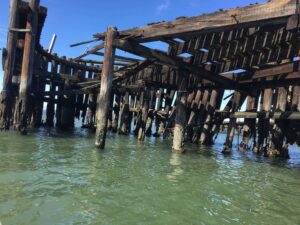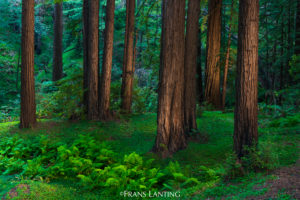No one who lived through the Oakland firestorm of 1991 will ever regard fire in quite the same way. My family was living in Piedmont at the time. I remember the look of panic on my daughter’s face when the ashes began to drift into our yard like light snow. Five friends who were evacuated from their own homes waited at ours, nervously watching the news. When the flames approached Piedmont, we packed the car with our most important belongings, anticipating evacuation. The fires stopped before we had to leave, but 12 families we knew lost their homes. The Oakland firestorm remains the most destructive fire and one of the most deadly in California history: 25 people killed, 2,900 homes and buildings destroyed.
Fast-forward to 2012, a few miles from where that fire started, to the East Ridge Trail in Redwood Regional Park in Oakland. Over the last year, the hikers and dog walkers who use this popular trail have watched work crews fighting fire with fire. First, the crews cleared dead brush and vines and raked them into large slash piles. Then, over the winter, firefighters burned those piles one by one, standing by with hoses until the smoke finally stopped. This fall, fire crews will take the next step: a “broadcast underburn”–a low-intensity fire under the trees in the 30-acre tract–to clear out the remaining brush and weeds.
It’s all part of an ambitious, comprehensive plan by the East Bay Regional Park District (EBRPD) to reduce the risk of an uncontrolled wildfire by getting rid of some of the fuel on its parklands. The effort, officially called the Wildfire Hazard Reduction and Resource Management Plan, is mainly geared toward public safety, but a secondary goal is to improve conditions for the plants and animals that live in the affected areas. It is a complicated plan and a challenging one to implement. The district has already faced one lawsuit (which was settled) and is still negotiating with another local group over how some of the details will play out. Several years ago, when the district took the first step in Redwood Regional Park, cutting down many of the Monterey pines and eucalyptus, there was a flurry of protest from some locals, including dog walkers and hikers. Ultimately, the district agreed to take out fewer trees than planned. This backdrop hints at some of the complexity involved when you add the human element into wildland planning. There is no telling what the reaction will be when those fire trucks roll out in the fall for the broadcast burn.

The Plan
The district’s Assistant Fire Chief John Swanson has stacks of papers and charts to explain how agency officials decided exactly what to do and where. First, planners and scientists studied 20,000 acres of district parkland, from Point Pinole in Richmond through the Oakland-Berkeley hills south to Lake Chabot, to determine which specific areas were most at risk during fire season in late summer and fall. That’s when the vegetation is driest and warm “Diablo winds” blow from the east. The plan, which runs nearly 400 pages, was released in 2009 and outlines fire management actions for 3,000 acres of parkland. Swanson says most of the areas identified as highest risk are along the western boundaries of the parks. “That only makes sense,” he says. “Where the Diablo winds are blowing from the east toward the Bay, you would expect that a fire that started in the park would be blown by the wind into residential areas. So our best place to prevent or reduce the potential for damage would be right at the boundary with the residential areas.”
The highest-risk areas were broken up into 129 smaller parcels and in each one, the district came up with an individual plan or prescription, detailing what it would do. In most, that involves clearing brush or thinning trees in strategic areas, using everything from weed whackers to tractors to goats.
The Fire Site
The narrow, mile-long stretch called #RD001 in Redwood Park is the only tract designated for a broadcast underburn. You wouldn’t expect that to be an easy sell near the site of the 1991 firestorm, where residents jump at the mention of fire. But most people on the East Ridge Trail seem unaware of the plan, even though the district has held public hearings.
The Hills Conservation Network, which has sued to stop the district from cutting stands of eucalyptus, supports the burn. “We like the idea of reducing ground fuel rather than cutting trees,” says Peter Scott, who serves on the group’s board. “So as long as wildlife and safety considerations are addressed, we are for it.”
The California Native Plant Society is reserving judgment. Its official comment is that it “has been in ongoing discussions with the East Bay Regional Park District for over 20 years regarding the impacts of vegetation management on native plant resources in the parks. Given the complexity of the topic of the proposed prescribed burn at Redwood Park, CNPS reluctantly declined the opportunity to comment other than to say that the confused goals of the plan make for dubious benefits to the public.”
Despite that controversy, the district’s fire experts say this particular spot is a perfect place for a planned burn, partly because of its location between two wide trails accessible by fire trucks. “They already have the equipment there. They don’t have to find the fire and get there,” explains fire expert Carol Rice, “and they have access on both sides to control it.” Rice, coauthor of a book about managing fire at the edges of cities and towns, was one of the consulting scientists on EBRPD’s extensive plan to reduce wildfire risk. She points out that this tract has actually been burned several times before, during the ’70s and ’80s, so the district has on-the-ground experience here; in fact, Rice was on site during one of the burns as a graduate student.
Fire on the Landscape
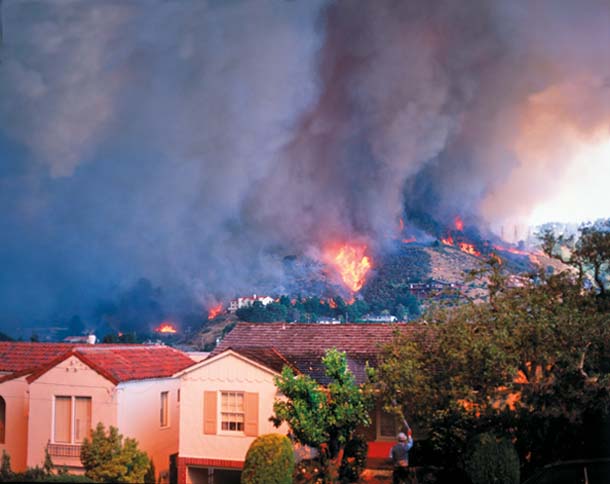
Fire ecology, the study of the natural incidence of fire and its role in the environment, is becoming a more important specialty in California, and for an important reason: Fires are becoming more frequent and more destructive. Janet Upton, deputy director for the California Department of Forestry and Fire Protection, says of the 20 largest fires (in acreage) in the state’s recorded history, more than half have occurred just since 2002. Professionals call a really huge fire a “siege” fire, as in “we’re under siege.” Upton says, “Before, maybe a firefighter would have one ‘siege’ fire in a career. Now, fire professionals have dozens of them.”
Seventy percent of those siege fires happened in heavily populated counties, including Los Angeles, San Diego, Santa Barbara, and Ventura, where housing is woven into the canyons, hills, and open spaces, like in many neighborhoods here in the Bay Area. Fire danger is especially high in dry chaparral, where fires are fast-moving and notoriously hard to stop. “These fires are inherently intense anyway,” says Neil Sugihara, fire ecologist for the U.S. Forest Service and editor of the book Fire in California’s Ecosystems. “They’re dangerous fires by nature. It’d be perfectly fine if we didn’t live here.”
But of course, we do now, and in ever greater numbers. Almost all of the fires in the so-called “wildland urban interface” (WUI or “wooie,” as some call it) are caused by people. Some are outright arson, but others are started inadvertently with cars, power tools, or burning leaves or debris. Either way, the bottom line is people cause fires, and there are a lot of people in California.
Many Native Californian peoples used fire to reduce the buildup of brush, making it easier to hunt and clearing the way for desired plants and sprouts. But now, we have done almost the opposite–adding fuel rather than burning it away. Neil Sugihara points out we have brought in invasive, highly flammable species, “like eucalyptus, French broom, and Monterey pines, which create more fire load in the community.”
The buildup of this “fire load” was also the result of policy. On federal lands, the “10 a.m. policy” became the rule in 1935: put the fire out before 10 a.m. tomorrow. Some called it a “war on fire.” But the 10 a.m. policy backfired in an unexpected and ironic way. It led to a thicker understory and more dead wood, so when fires do start, they are more intense. The policy was officially abandoned in 1978, and since then land managers have gradually begun to understand that fire has an important role in ecosystems. On federal land, officials now have the flexibility to let some wildfires burn themselves out. But land managers can’t do that next to residential neighborhoods where lives and property are at stake, so the underbrush in the WUI often builds up unabated.
With California’s normal drought cycle and the prospect of climate change bringing even more drought, it’s no surprise that firefighters are concerned. “Drought-stressed trees are more susceptible to disease and fire,” says Janet Upton.
The Burn
This is where we get back to fighting fire with fire. The EBRPD plan is to conduct the prescribed ground-level burn in Redwood Regional Park this fall, right in the middle of the fire season. That may seem like an invitation for trouble, but Assistant Fire Chief Swanson says there are reasons for the timing and he is confident in the precautions being taken to prevent the flames’ escape. “That’s why we have a plan that tells us the best way to safely burn.” In March 2012, piles of slash were burned to make sure the planned broadcast burn will be a low-intensity fire. Work crews cut the lower branches of trees to prevent any flames from climbing into the canopy; and the firefighters will only burn on a day when the winds and humidity will work in their favor.
In the fall, “we can burn more efficiently and with less smoke,” says Swanson. And it’s safer for wildlife: “In terms of birds and animals, basically the nesting season is over.”
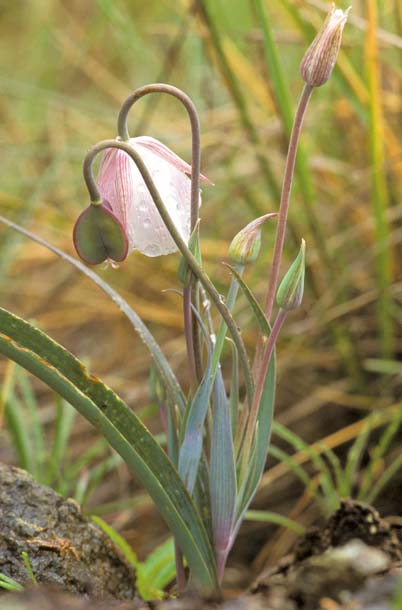
In designing the plan, EBRPD ecologists surveyed the area to make sure no endangered animals or plants would be negatively affected. District Stewardship Resource Analyst Jessica Sheppard says traps were set to determine whether the Alameda whipsnake lived there, but she wasn’t surprised that none were caught. “It’s not good habitat for the whipsnake,” she says. “They don’t live in mature shaded forests.” The dusky-footed wood rat is not endangered or threatened, but all wood-rat nests in the burn area were located and flagged. Work crews were careful to avoid them and, Sheppard says, “they developed a clear buffer area around each one that allows them an escape route.”
There are two listed plants in the tract: the Oakland star tulip and the pallid manzanita. The tulip will be dormant in the fall, and ecologists hope the pallid manzanita and other natives will actually benefit from the burn.

The federally threatened pallid manzanita actually reappeared after the completion of the first installment of the district’s fuel mitigation plan, several years ago, when crews cut down many of the mature eucalyptus and Monterey pines on both sides of the East Ridge Trail. A year later, two colonies of pallid manzanitas sprouted–one around the single existing tree on East Ridge, and the second in an area a quarter-mile away. Pallids are thought to need fire to germinate, and it isn’t clear whether the disruption or the increased sunlight and warmth caused these plants to sprout.
Jessica Sheppard hopes the fire will bring out more pallids and other native species as well. “It would be great to see the oaks, bays, and madrones continue to grow there. If I could work some magic I would see coffeeberry, snowberry, flowering currant, ocean spray, and hazelnut,” all of which do exist in the area and some of which are thriving in places where the brush was cleared.
But the district’s overall goal for the tract remains a mostly nonnative ecosystem: “open Monterey pine stands with understory of pine litter, grassland, and scattered low shrubs and annual grasses”–neither the pines nor the annual grasses are native. And then there are unwanted but ever-present exotic invasives including several different kinds of thistle, poison hemlock, oblong spurge, and French broom. Many of the exotic perennials and biennials have thick taproots and will easily survive a fire.
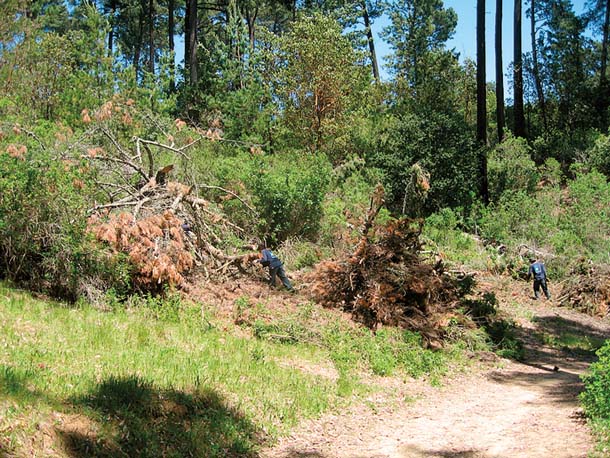
“Realistically, we know that the invasives are present and will return,” Sheppard says. “Diversity is the key to adaptability and though we are pro-native, we recognize that our landscape includes a balance of native and nonnative vegetation.”

Achieving that balance can be difficult after a burn. Fire stimulates the germination of some plants, including invasives. Already, in some of the blackened spots where firefighters burned slash piles in Redwood Regional Park, weeds are sprouting profusely. Some of the broom sprouts look like they’re on steroids: twice as large as normal seedlings and already sprouting out branches, something that usually doesn’t happen until their second year. They are apparently benefiting from the nutrients in the ashes, which act like fertilizer.

Sheppard says the district’s plan calls for follow-up to deal with such problems: “What we know is you can’t treat the area and then just leave. It’s a long-term commitment. Our vegetation and integrated pest management experts will go back out there, document, and then we’ll decide what to do.” The district hasn’t set a detailed budget for this yet, but it does have maintenance funding from a 2004 voter-approved bond measure and it will also have some rules to follow. Federal officials require the district to monitor all the treated parcels for 10 years, and although the specifics aren’t spelled out yet, the monitoring will include a goal to reduce noxious weeds.
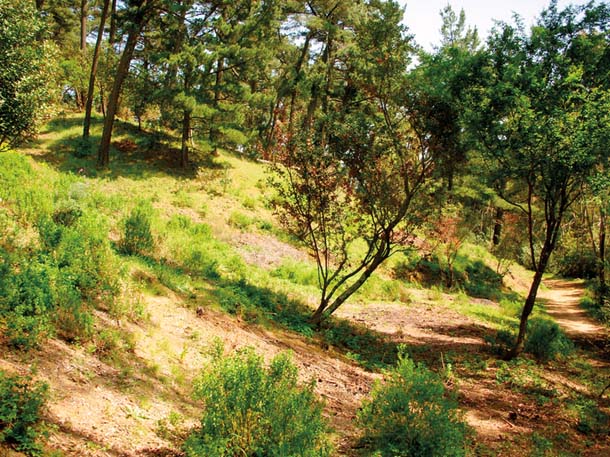
The French broom may offer an interesting test case because there’s a lot of it in the tract and volunteers (including me) have been trying to control it for about seven years. Sheppard says the fire may flush out the broom seed bank–thousands of stored seeds that can live for more than 20 years in the soil. “If the broom seed bank is flushing out, let’s document it and do something about it,” she says. If the district can effectively deal with this explosion of sprouts, it may significantly reduce the broom seed bank. But if it can’t keep up with the broom and the other weeds, the result could be a mess.
How that issue will unfold is hard to say, and Sheppard emphasizes that reducing fire danger is job one: “This is not a restoration project. Our primary goal is fuels reduction… . We all want to have a fire-safe community, and that is achieved by a balance of supporting the local ecology with the ever-present limitation of available resources.”
Given the threat of a major fire, invasives are one risk the park district is willing to accept. As fire ecologist Carol Rice points out, “Fire is the only natural disaster we can do something about.” We can’t do much about earthquakes or tornadoes, but, she says, “You can change the behavior of fire. We can make a difference before it happens.”


